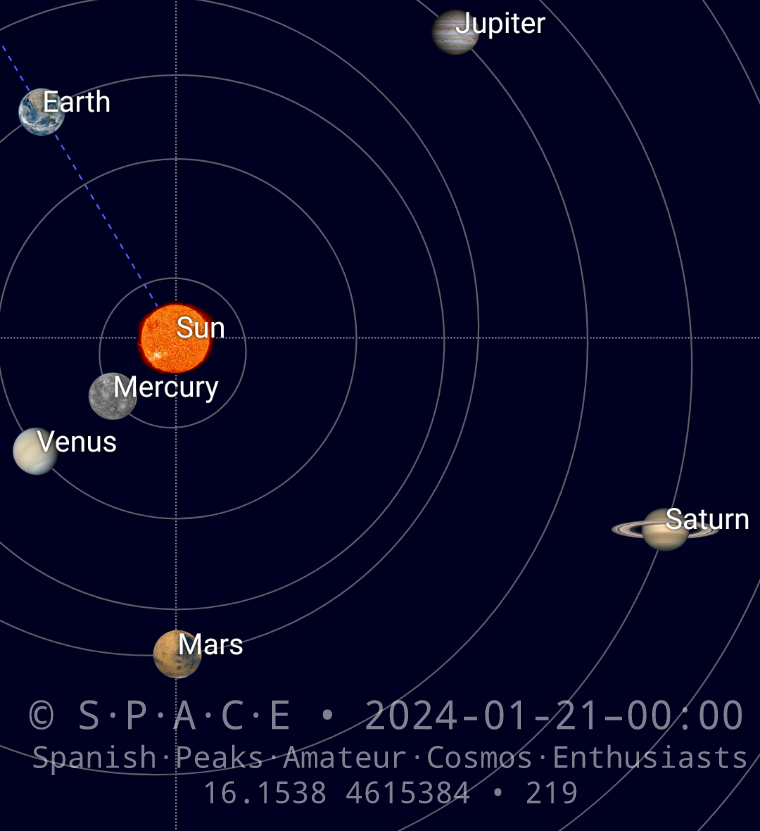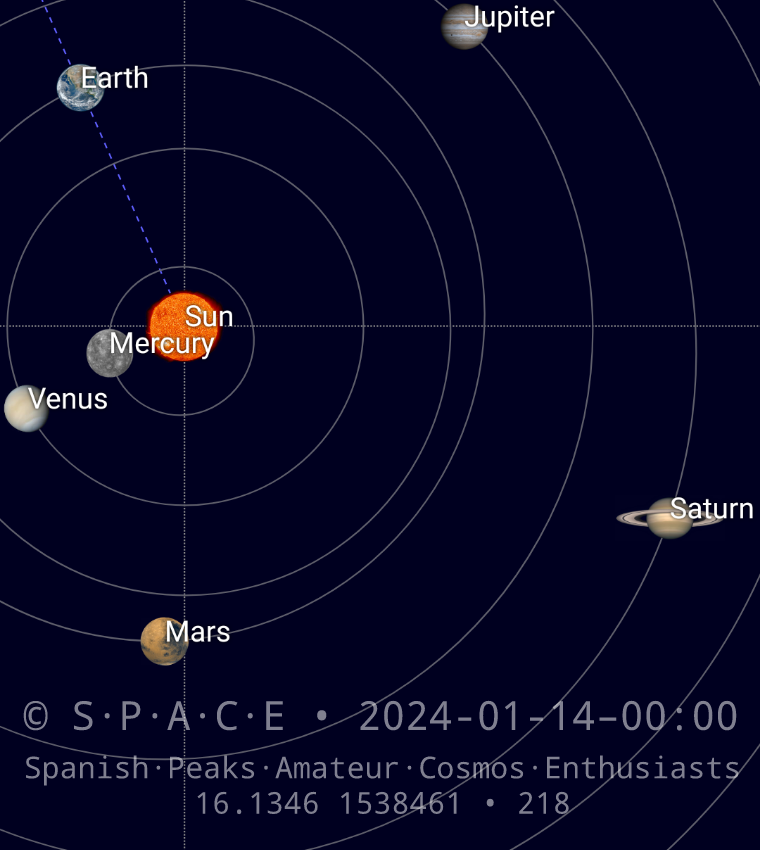by William J. Bechaver
Mars remains difficult to spot in the morning sky. It is so distant, right now, and appears so low, rising only an hour before the Sun, that it is lost in the Sun’s glare except for only under the most ideal conditions.
Tiny Mercury is moving further off, and sinking lower in the sky each day, and becoming more difficult to sight as well.
Only Venus in the morning sky is really easy to find. No matter how far from Earth it moves, it continues to glow brightly high in the sky.
Mercury remains the nearest planet to Earth, and will continue to for some time, but Venus always out shines Mercury, regardless of its distance.
Venus is much larger than Mercury or Mars, and it is covered in a layer of bright, reflective clouds. So, it tends to dominate the morning sky.
Venus is only slightly smaller than Earth, while Mercury is only slightly larger than our Moon. So Mercury doesn’t stand a chance to outshine Venus, even during its best appearance.
But this week, we will be treated to a pairing of the dimmer of the three planets, so keeping Mercury in view each morning, will eventually help us find Mars, as the two come together and effectively pass each other in the morning sky.
On the morning of Saturday 27 January, Mercury will be slightly higher than distant Mars, low in the bright sky before the dawn of the new day.
Go out about forty five minutes before sunrise, at about 6:15, and look to the east. Low on the horizon, to the lower left of brilliant Venus above, try to find fading Mercury and nearing Mars as the two planets come together in the morning sky.
Mercury will be only slightly to the upper left of dimmer Mars. The planets will appear less than half a degree apart at their rising.
On Saturday morning, Mercury will rise only 1 minute, 17 seconds before Mars, and appear slightly higher in the sky than the red planet.
By Sunday 28 January, their positions will be changed, as Mars will rise 1 minute, 42 seconds before Mercury. Watch for the switch, for on Sunday morning, Mars will appear higher than Mercury.
From this day onward, Mars will rise earlier, and remain higher in the sky, while Mercury will be lower, and continue to sink rapidly toward the glow of the Sun.
As Mars continues to climb, our viewing opportunities for the distant rocky world will increase and improve. Mars will slowly edge its way out of the glare and into the darker sky before sunrise, as Earth is slowly drawing nearer the distant planet.
Mercury will continue to speed away, and as it sinks, it is preparing to pass around the far side of the Sun, and out of view for us on Earth for a short while.
Mercury speeds around the Sun so rapidly in its shorter orbit, it makes progress quickly, moving in the sky faster than any other planet.
However, Mars is only progressing in its orbit a little slower than Earth. So, we gradually gain on it, but its progression out of the sunlight will be much slower than Mercury’s dive around the Sun.
Now the motion of Venus is becoming apparent as it is also moving away from Earth. It is sinking lower in the morning sky as well, and now rises less than two hours before the Sun.
But its motion is slower also, and its descent will be deliberate. But watch in the next few months as Mars forever continues the climb upward, and Venus methodically makes its descent. The distance between the two will gradually decrease, and they will become a dominant pair in the morning sky.
The evening planets, Saturn and Jupiter, are making their way across the evening sky. Saturn now sets in the evening hours, only a little more than two hours after the sky has darkened, so our chances of viewing the distant, ringed planet, are growing short.
Jupiter sets after midnight this week, but with its motion ever westward, it will be setting before midnight before the week is out, remaining a truly night planet.
Then, after midnight, there are no planets to be observed in the night sky until the early morning Venus rises in the east.
The fascinating motion of the planets is always intriguing, and watch this week as Mars takes over one position, to rise above Mercury, gaining elevation to eventually take over the top position as highest planet in the morning sky.
With our dark skies here, they only need to be clear, so keep your eyes on the skies from sunset to sunrise.
Thanks for the positive feedback about our featured columns, and your continued interest in astronomy. If you have any questions or article requests, contact us at spacescape@rocketmail.com, or follow us on Twitter @ColoSpacEScapE for updates and additional viewing opportunities.
ASTRONOMICAL TIMES AND DISTANCES of naked-eye objects for this weekend.
Sun Set = 5:17 p.m.
8 minutes later than last week
91.533 million miles from Earth
64,827 miles further than last week
129,754 miles further than its nearest in January
Moon Rise = 7:16 p.m.
60 minutes later than last night
251,973 miles from Earth
640 miles further than last night
12,039 miles further than last week
Nearest is 221,557 miles
Furthest is 252,665 miles
Saturn Set = 7:33 p.m.
24 minutes earlier than last week
983.884 million miles from Earth
5,638,872 miles further than last week
169.305 million miles further than its nearest in August
Jupiter Set = 12:31 a.m.
25 minutes earlier than last week
455.801 million miles from Earth
10,472,997 miles further than last week
85.477 million miles further than its nearest in November
Venus Rise = 5:05 a.m.
10 minutes later than last week
118 minutes before the Sun
124.931 million miles from Earth
3,617,375 miles further than last week
98.093 million miles further than its nearest in August
Mars Rise = 5:58 a.m.
7 minutes earlier than last week
65 minutes before the Sun
216.722 million miles from Earth
2,303,460 miles nearer than last week
20.262 million miles nearer than its furthest in October
Mercury Rise = 6:00 a.m.
14 minutes later than last week
63 minutes before the Sun
116.665 million miles from Earth
8,377,951 miles further than last week
53.488 million miles further than its nearest in December
Sun Rise = 7:03 a.m.
4 minutes earlier than last week
91.540 million miles from Earth
6,502 miles further than last evening
66,977 miles further than last week
136,256 miles further than its nearest in January
Third Quarter Moon occurs on Friday, February 2nd, at 4:18 p.m.
We’ve Gained 12 Minutes Of Daylight since last week, and 36 minutes since last month, and 37 minutes since the December Solstice.
Our Nearest Planetary Neighbor currently is Mercury.
No Planet In The Dark Sky for 4 hours 34 minutes. This is the duration between Jupiter Set and Venus Rise in the early morning. No naked-eye planets are visible during this period.
Note: Times are local Mountain Time. Actual “sundown” is about a dozen minutes earlier than calculated “sunset”. Along the front range, differing times vary depending on your distance from the mountains.
________________
• · William J. Bechaver is the director of SPACE • Spanish Peaks Amateur Cosmos Enthusiasts, the premier Astronomical Society for Southern Colorado and Northern New Mexico.

S·P·A·C·E•Date 16.1730 • 220
________________


